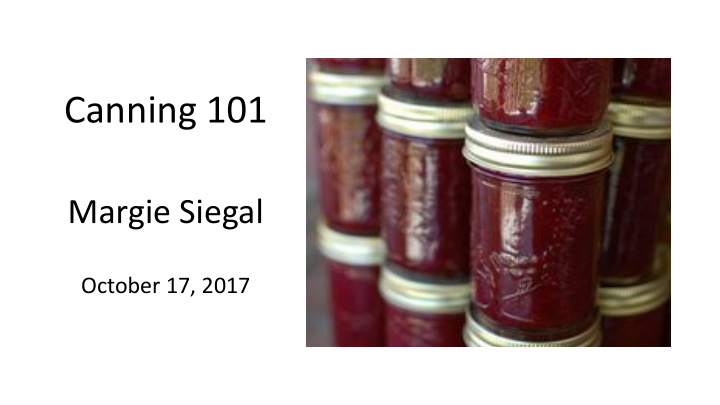



Canning 101 Margie Siegal October 17, 2017
• Preserve the harvest. • Know and control what you eat. • Make something special. Why Can?
Sources of Spoilage • Natural bacteria and fungi. • Enzymes in food.
Cleanliness is Critical • Scrub kitchen. • Clean utensils. • Boil jars and lids.
Safety First! Never reduce vinegar or lemon juice amounts.
Always Be Careful • Large quantities of boiling water and sharp knives used in canning. • Wear closed-toe shoes. • Don't try to lift a pot beyond your capabilities.
How-Tos • Add produce to jar. • Remove bubbles. • Leave head space.
How-Tos • Wipe top of jar. • Heat lids, place on jars. • Screw on rims.
Proper Processing High Acid Low Acid • Chutney and salsa • Tomato sauce with added • Pickles onions, etc. • Dilly beans • Anything not listed as • Plain tomatoes (add high acid acid?) • Any fruit • Jams and jellies
Proper Processing High Acid – Boiling Water Bath • Boiling water needs to cover jars. • Time per National Center for Food Preservation; start timing after water boils again.
Proper Processing Low Acid – Pressure Canner • Time 10 minutes • Heat water • Add jars • Slap on weight, wait until indicator reads 10 lbs and • Bolt down lid weight jiggles • Heat until steady • Then time per Natl Center stream of steam for Food Preservation appears
Finishing Up • Remove jars. Canning tongs very helpful. • Keep vertical. • Let cool.
Finishing Up Check jars to make sure button on lid is sucked down.
Fi Finishing Up g Up • Wipe down Jars. • Label with date and contents. • Repack in the box they came in. • Store in a dry, hopefully dark place.
• Questions?? The image part with relationship ID rId2 was not found in the file.
Recommend
More recommend